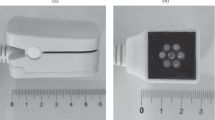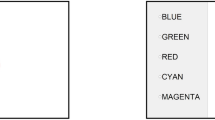Abstract
The control of human forearm cutaneous vascular resistance was examined using a combination of laser Doppler perfusion measurement and continuous Finapres blood pressure measurement. Tests which provoke changes in blood flow via different control mechanisms (local and neural) were applied in a group of ten healthy subjects. The purpose was to select from them a suitable (i.e. statistically significant) group to apply in cases where a disease process is suspected of interfering with the control of the skin circulation. Deep inspiration, immersion of the feet in water at 15°C (both eliciting sympathetic vasoconstrictor nerve activity) and arm dependency (eliciting the local veni-arteriolar response) produced statistically significant, symmetrical increases in cutaneous vascular resistance in both arms (p < 0.05, Wilcoxon's test for paired differences). Similarly, post-ischaemic reactive hyperaemia (mediated by local vasodilator mechanisms) and indirect heating of the body (eliciting increased sympathetic vasodilator nerve activity) resulted in significant decreases in cutaneous vascular resistance (p < 0.01). When deep inspiration was repeated from a vasodilated baseline after indirect heating, the increases in cutaneous vascular resistance were smaller than those obtained before heating. Isometric handgrip exercise failed to produce a significant change in contralateral cutaneous vascular resistance (p > 0.05). There were no differences between right and left arms for any test (p > 0.05). The successful tests were subjected to power analysis in order to predict likely patient sample sizes required to demonstrate altered responsiveness at sites of microcirculatory disturbance compared with normal skin.
Similar content being viewed by others
References
Roddie IC. Circulation to skin and adipose tissue. In Shepherd JT, Abboud FM, eds.Handbook of Physiology, Vol III, part 1. Bethesda, MD: Am Phys Soc, 1983: 285–317.
Bates DO, Levick JR, Mortimer PS. Starling pressures in the human arm and their alteration in postmastectomy oedema.J Physiol 1994;477: 355–363.
Bates DO, Levick JR, Mortimer PS. Change in macromolecular composition of interstitial fluid from swollen arms after breast cancer treatment, and its implications.Clin Sci 1993;86: 737–746.
Imholz BPM, van Montfrans GA, Settels JJ, van der Hoeven GMA, Karemaker JM, Wieling W. Continuous non-invasive blood pressure monitoring: reliability of Finapres device during the Valsalva manoeuvre.Cardiovasc Res 1988;22: 390–397.
Wahlberg E, Olofsson L, Swedenborg J, Fagrell B. Effects of local hyperemia and edema on the biological zero in laser Doppler fluxmetry.Int J Microcirc: Clin Exp 1992;11: 157–165.
Colantuoni A, Bertuglia S, Intaglietta M. Biological zero of laser Doppler fluxmetry: microcirculatory correlates in the hamster cheek pouch during flow and no flow conditions.Int J Microcirc: Clin Exp 1993;13: 125–136.
Fagrell B. Problems using laser Doppler on the skin in clinical practice. In: Belcaro GV, Hoffmann UH, Bollinger A, Nicolaides AN, eds.Laser Doppler. London, Los Angeles, Nicosia: Med-Orion, 1994; 49–54.
Peñaz J. Photoelectric measurement of blood pressure, volume and flow in the finger. In:Digest of the International Conference on Medicine and Biological Engineering. Conference Committee of the Xth International Conference on Medicine and Biological Engineering. Dresden, 1973: 104.
Schechner JS, Braverman IM. Synchronous vasomotion in the human cutaneous microvasculature provides evidence for central modulation.Microvasc Res 1992;44: 27–32.
Shepherd JT. In:Physiology of the Circulation in Human Limbs in Health and Disease. Philadelphia, PA: WB Saunders, 1963: 127–138.
Browse NL, Hardwick PJ. The deep breath—venoconstriction reflex.Clin Sci 1969;37: 125–135.
Mohan J, Marshall JM. Responses in the human forearm evoked by indirect cooling.J Physiol 1992;446: 213P.
Pickering GW. The vasomotor regulation of heat loss from the human skin in relation to external temperature.Heart 1933;16: 115–135.
Roddie IC, Shepherd JT, Whelan RF. The contribution of constrictcr and dilator nerves to the skin vasodilatation during body heating.J Physiol 1957;136: 489–497.
Levick JR, Michel CC. The effects of position and skin temperature on the capillary pressures in the fingers and toes.J Physiol 1978;274: 97–109.
Flynn MD, Hassan AAK, Tooke JE. Effect of postural change and thermoregulatory stress on the capillary microcirculation of the human toe.Clin Sci 1989;76: 231–236.
Henriksen O. Local nervous mechanism in regulation of blood flow in human subcutaneous tissue.Acta Physiol Scand 1976;97: 385–391.
Cotzias C, Marshall JM. Differential effects of isometric exercise on the cutaneous circulation of different regions.Clin Auton Res 1992;2: 235–241.
Snedecor GW, Cochran WG. In:Statistical Methods. Ames, IA: Iowa State University Press, 1967: 111–114
Bland M.An Introduction to Medical Statistics. Oxford, New York, Tokyo: Oxford University Press, 1987.
Del Guercio R, Leonardo G, Arpaia MR. Evaluation of postischaemic hyperemia on the skin using laser Doppler velocimetry: study on patients with claudication intermittens.Microvasc Res 1986;32: 289–299.
Rodgers PG, Schecter AN, Noguchi CT, Klein HG, Nienhuis AW, Bonner RF. Microcirculatory adaptations in sickle cell anemia: reactive hyperemia response.J Appl Physiol 1990;258: H113-H120.
Love AHG, Shanks RG. The relationship between the onset of sweating and vasodilatation in the forearm during body heating.J Physiol 1962;162: 121–128.
Nilsson GE, Tenland T, Oberg PÅ. Evaluation of a laser Doppler flowmeter for measurements of tissue blood flow.IEEE Trans Biomed Eng BME 1980;27: 597–604.
Braverman IM, Keh A, Goldminz D. Correlation of laser Doppler wave patterns with underlying microvascular anatomy.J Invest Dermatol 1990;95: 283–286.
Gilliat RW. Vaso-constriction in the finger after deep inspiration.J Physiol 1948;107: 76–88.
Bolton B, Carmichael EA, Sturup G. Vasoconstriction following deep inspiration.J Physiol 1936;86: 83–94.
Zbrozyna A, Westwood D. Habituation and recovery of vascular responses in calf and forearm and of level of pain sensation during cold pressor test in man.Eur J Appl Physiol 1990;61: 106–111.
Doupe J, Cullen CH, Macaulay LJ. Studies in denervation. F. The circulation in the skin in the proximal parts of the limbs.J Neurol Neurosurg Psychiatry 1943;6: 129–132.
Edholm OG, Fox RH, Macpherson RK. Vasomotor control of the cutaneous blood vessels in the human forearm.J Physiol 1957;139: 455–465.
Marshall JM, Stone A, Johns EJ. Analysis of the responses evoked in the cutaneous circulation of one hand by heating the contralateral hand.J Auton Nervous System 1991;32: 91–100.
Benzinger TH. Heat regulation: homeostasis of central temperature in man.Physiol Rev 1969;49: 671–759.
Grant RT, Holling HE. Further observations on the vascular responses of the human limb to body warming; evidence for sympathetic vasodilator nerves in the normal subject.Clin Sci 1938;3: 273–285.
Brengelman GL, Freund PR, Rowell LB, Olerud JE, Kraning KK. Absence of active cutaneous vasodilatation associated with congenital absence of sweat glands in humans.Am J Physiol 1981;242: H593-H601.
Taylor WF, Johnson JM, Kosiba WA, Kwan CM. Cutaneous vascular responses to isometric handgrip exercise.J Appl Physiol 1989;66: 1586–1592.
Taylor JA, Hand GA, Johnson DG, Seals DR. Sympathoadrenalcirculatory regulation during sustained isometric exercise in young and older men.Am J Physiol 1991;261: R1061-R1069.
Cotzias C, Marshall JM. Vascular and electromyographic responses evoked in forearm muscle by isometric contraction of the contralateral forearm.Clin Auton Res 1993;3: 21–30.
Author information
Authors and Affiliations
Rights and permissions
About this article
Cite this article
Stanton, A.W.B., Levick, J.R. & Mortimer, P.S. Assessment of noninvasive tests of cutaneous vascular control in the forearm using a laser Doppler meter and a Finapres blood pressure monitor. Clinical Autonomic Research 5, 37–47 (1995). https://doi.org/10.1007/BF01845497
Received:
Accepted:
Issue Date:
DOI: https://doi.org/10.1007/BF01845497




